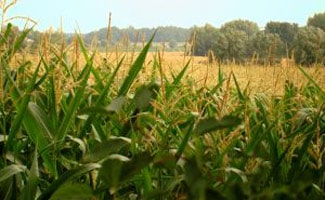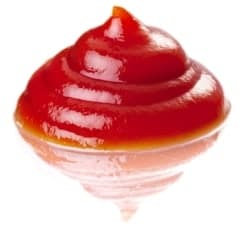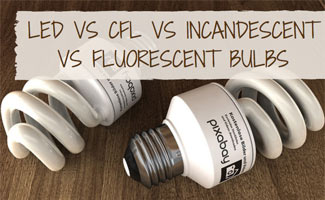Yikes! High Fructose Corn Syrup Health Risks
 High Fructose Corn Syrup, or HFCS for short, is a sweetener derived from corn. The syrup made from corn undergoes enzymatic processing in a lab to turn some of its glucose into fructose, making it sweeter. HFCS is much cheaper to process than sugar (due to import taxes on sugar and corn is produced domestically in the U.S.), therefore many food companies choose to use high fructose corn syrup in their products instead of the more expensive sugar. This shift happened in the past 50 years as the government provided subsidies to U.S. farmers (read: they make more money growing corn and soy (also subsidized) than other crops) to provide incentive to grow more corn for mass food production. The lower cost of corn vs. sugar drives prices down on the more processed foods and keeps the prices of foods containing real sugar higher. It’s easy to see why companies might choose to go this route and it’s also easy to see why people are more inclined to buy these products. The company can sell more products due to the lower cost and the cost of production is low. The consumer likes the price tag and can’t really taste the difference. So, what’s the problem and what are the High Fructose Corn Syrup health risks?
High Fructose Corn Syrup, or HFCS for short, is a sweetener derived from corn. The syrup made from corn undergoes enzymatic processing in a lab to turn some of its glucose into fructose, making it sweeter. HFCS is much cheaper to process than sugar (due to import taxes on sugar and corn is produced domestically in the U.S.), therefore many food companies choose to use high fructose corn syrup in their products instead of the more expensive sugar. This shift happened in the past 50 years as the government provided subsidies to U.S. farmers (read: they make more money growing corn and soy (also subsidized) than other crops) to provide incentive to grow more corn for mass food production. The lower cost of corn vs. sugar drives prices down on the more processed foods and keeps the prices of foods containing real sugar higher. It’s easy to see why companies might choose to go this route and it’s also easy to see why people are more inclined to buy these products. The company can sell more products due to the lower cost and the cost of production is low. The consumer likes the price tag and can’t really taste the difference. So, what’s the problem and what are the High Fructose Corn Syrup health risks?
High Fructose Corn Syrup Facts
Any time I hear that a food has undergone changes in structure in a lab, it sets off warning bells in my head. Corn is naturally sweet. Maybe not sugary sweet (although some varieties are pretty sweet), but sweet none the less. To add chemicals and cause it to undergo large changes in composition seems bizarre and dangerous.
Banned In Other Countries
The government approves the use of HCFS in products made in the U.S., but some countries have outlawed it. Why? I wondered what made them take such drastic steps to keep it out of their foods if the U.S. deems it safe for human consumption. Is it dangerous? I really didn’t know.
My kids (and I) have certainly consumed it. My husband is a Pepsi addict (UGH! I HATE HATE HATE spending money on soda. Empty calories and if it is corrosive enough to break through a clogged drain! So what is it doing to your insides??? These are scary enough thoughts to make me pretty much avoid it and I wish I could get my husband to do the same. Maybe one day, but I digress…). So he’s certainly had his share of HFCS.
HFCS Linked to Obesity
 So, is it really dangerous? The answer isn’t as simple as the proponents of corn-based products would like you to believe. Simply put, it really isn’t any more “dangerous” than sugar. But, since HFCS has found its way into so many products (even baby formula!), consumption has also increased (more than 1,000% since the 1970’s according to some sites including Huffington Post).
So, is it really dangerous? The answer isn’t as simple as the proponents of corn-based products would like you to believe. Simply put, it really isn’t any more “dangerous” than sugar. But, since HFCS has found its way into so many products (even baby formula!), consumption has also increased (more than 1,000% since the 1970’s according to some sites including Huffington Post).
In a day when obesity is an epidemic in our country, it is something to be concerned about. Sure, the body seems to process it the same way that it processes any type of sugar. That isn’t the problem – although no long-term studies have been done, so long-term effects may still show up. In fact, recent studies show that HFCS can trigger inflammation throughout the body. The problem is that so many foods hide high fructose corn syrup in the ingredients – even in products that it doesn’t really “need” to be in like breads. Is it really THAT much more expensive to put a Tablespoon of sugar in a loaf of bread than HFCS? Nature’s Own doesn’t think so. Their bread is HFCS-free and it really isn’t any more expensive than other leading brands of bread). Because it is so prevalent in our diet, it can be connected to heart disease, diabetes, and cancer. (just to name a few).
Overconsumption of HFCS is a major one and it isn’t likely to be resolved any time soon. Between 1970 and 1990, the consumption of high fructose corn syrup increased more than 1,000%. This is because manufacturers are using it more and more due to its preservative qualities and its lower cost. More than 40% of all caloric sweeteners added to foods and drinks are from high fructose corn syrup.
Does HFCS Contribute To Diabetes?
Glucoseis a simple sugar form that is transported through the body in the blood. This is what the body uses for energy. When diabetics test their blood sugar, it is the glucose they are measuring. Fructose, on the other hand, does not stimulate insulin secretion or require insulin to be transported into the cells. Fructose requires a different metabolic path than other carbohydrates because it skips the normal process of carbohydrate metabolism. As a result, fructose is an unregulated source of the starting material for fatty acids to form. This leads to over eating and excessive weight gain which is very dangerous to diabetics.
Can HFCS Be Avoided?
It is possible to avoid high fructose corn syrup altogether if you are vigilant about it. Checking food labels is crucial, but there are some grocery stores that have special sections for “health foods” and there is often a specific non-HFCS section. Eating whole foods is also a good, natural way to avoid HFCS. High fructose corn syrup is most commonly found in processed foods. If you make your food from scratch, you can easily put in real sugar (if you are concerned about the processed part, use raw sugar instead of white sugar) or sweeten your food in other ways such as honey or agave. Just keep in mind that sugar is sugar is sugar and too much of a good thing is, well, too much of a good thing. Moderation is the key with any type of sugar. Moderation is just hard to achieve where HFCS is concerned.
How do we define “too much” high fructose corn syrup consumption, or what it means to consume it in “moderation”? In my research, I was unable to find any recommendation for a maximum limit. Therefore, my personal conclusion is that because high fructose corn syrup is estimated to be in more than 40% of all foods, we can safely achieve “moderation” only when we aim to limit it all together. In other words, if we strive for total abstinence, high fructose corn syrup is sure to slip in unnoticed and when we least expect it to; this unaccounted for and out-of-our-control consumption is likely to be enough to be classified as “moderate consumption”.
Tips to Cut Back on High Fructose Corn Syrup
Some simple ways to not only cut down on high fructose corn syrup consumption, but also to moderate your sugar intake, as a whole, are to:
- Replace sweets with fruits (fruits still contain sugar, but naturally occurring sugars in fruits combine with healthy vitamins and minerals instead of giving you empty calories)
- Don’t buy processed foods – eat a whole food diet, when possible, with fresh, non-processed ingredients
- Buy organic – even processed organic foods tend to contain real sugar
- Real the label – if you see high fructose corn syrup in the ingredient list, do not buy it
If you occasionally treat yourself to a soda or white bread, don’t beat yourself up. It is a factor in the obesity epidemic, but that has to do with over consumption vs. the actual product itself.
Ending the Epidemic
 Will removing high fructose corn syrup from your diet really end the obesity epidemic that has overtaken the United States? It probably won’t alone. An overall healthy diet and an active lifestyle including exercise are crucial to turning the trend around. A part of that is monitoring how much processed food goes into your diet. Since almost all processed food includes HFCS, it is an integral piece of the puzzle to ending obesity. Read labels and take responsibility for what goes into your body. Your body, your family and your future, will thank you for it.
Will removing high fructose corn syrup from your diet really end the obesity epidemic that has overtaken the United States? It probably won’t alone. An overall healthy diet and an active lifestyle including exercise are crucial to turning the trend around. A part of that is monitoring how much processed food goes into your diet. Since almost all processed food includes HFCS, it is an integral piece of the puzzle to ending obesity. Read labels and take responsibility for what goes into your body. Your body, your family and your future, will thank you for it.
11 Unexpected Foods that You Will Find High Fructose Corn Syrup In
High fructose corn syrup is found in many foods that are produced in the United States. This is because it is cheap, made from corn and therefore in abundant supply, and acts as a preservative to boot.
Naturally sweet, it has come to be a cheap alternative to table sugar and baking sugar, as well. Over-consumption of high fructose corn syrup has become a health concern for many, as the ingredient is listed in literally thousands of different foods, including many that are unexpected.
The average American eats over 41.5 pounds of high fructose corn syrup annually, and it has similar detrimental effects on your health as cane sugar does.
Cardiovascular disease, obesity, and diabetes are all linked to excess sweetener consumption, and dentists cite high fructose corn syrup as the cause of many cavities and other dental issues. Genetic modification of corn that is used to produce high fructose corn syrup is also a rapidly growing concern for consumers. Juices and soft drinks, as well as candy, cookies, canned fruit, and other sweets are famous for their use of high fructose corn syrup as a principal ingredient. Yet it can be lurking in many places you might not expect, such as:
- Yogurt: Flavored yogurt can provide you with more than seventy percent of your daily sugar intake in a single serving. High fructose corn syrup prevents the solids from separating from the liquid parts of the yogurt, preserving the creaminess. It also preserves the fruit in the yogurt by keeping it firm and preventing flavor loss. To minimize consumption, read labels carefully, and opt for plain or Greek-style yogurt in place of flavored, adding your own fruit, nuts, or cereal to taste.
- Salad dressing: Salads seem like a healthy option, but the wrong dressing can add sugar to even your most nutritious meal. High fructose corn syrup is said to enhance color, texture, and flavor in salad dressings. Choose a natural dressing made without sweetener such as Newman’s Own, or create your own salad topping using olive oil, herbs, and balsamic vinegar.
- Cereal: Starting your day off with heaps of sweetener can definitely lead to a mid-morning blood sugar crash, and you may be getting more than one day’s worth of sugars in a single serving of breakfast. Look for cereals that are made without high fructose corn syrup, such as Cheerios, Grape Nuts, or any of the all-natural Kashi brand cereals.
- Bread: Choosing an all-natural whole-grain variety without high fructose corn syrup may cost a little more, but the health savings will be numerous. High fructose corn syrup gives bread sweetness and lengthens a loaf’s shelf life, so you will need to use the bread a little faster. Look at the fine print on the ingredients list to be sure you are free of the sweetener when picking up bread or baked goods. This goes for pita bread, naan, baguettes, and all other bakery items, as well.
 Condiments: Ketchup, barbecue sauce, mayonnaise, and Worcestershire sauce may all contain high fructose corn syrup. Read ingredients before purchasing, and use sparingly if you must. The addition of this sweetener may extend shelf life and preserve color and texture, but is a sure way to add loads of sugar to nearly any meal.
Condiments: Ketchup, barbecue sauce, mayonnaise, and Worcestershire sauce may all contain high fructose corn syrup. Read ingredients before purchasing, and use sparingly if you must. The addition of this sweetener may extend shelf life and preserve color and texture, but is a sure way to add loads of sugar to nearly any meal.- Granola bars: Thought by many to be a healthy, high-energy snack, granola bars may as well be candy bars outright because of the amount of sugars these pack in. High fructose corn syrup preserves crunch and flavor, and gives that gooey-ness that people are crazy for, but will leave you drained and tired rather than energized. Pick a bagged trail mix instead, or choose brands that use regular sugar or are sweeter-free to lessen the sugar impact.
- Canned vegetables: Canned fruits were once preserved in heavy sugar syrup, but light sweetener prevails today in canned goods, including canned vegetables such as green beans, beets, corn, peas, mushrooms, kale, and more. Avoid these by choosing natural brands, many of which list that they are also low-sodium. If you are having trouble finding canned goods that are corn syrup-free, consider buying fresh as needed or at the least switching to frozen vegetables, which still last a long time but with much less sweetener.
- Soups: Canned soups are also relying heavily on high fructose corn syrup these days in order to stay preserved longer and to maintain flavor and soupiness. Bottled or boxed soups are also under the corn syrup spell. Amy’s brand of soups pack in flavor and shelf life without the added salt, preservatives, or corn syrup.
- Lunch meats: If you are not watching what you eat carefully, a baloney sandwich on white bread with mayo and barbecue sauce can be an unadulterated corn syrup trap. Lunch meats may not seem like a place for high fructose corn syrup to hide, but as a flavoring and preservative, lower-quality packaged meats are a very likely source for this sweetener. Smoked flavor, barbecue, or other flavored meats are also likely to have high fructose corn syrup enhancements. Fresh deli meats will last you a week or more and are much lower in sweeteners, or choose packaged deli meat that is corn syrup-free.
- Pasta sauce: Tomato sauce, Alfredo sauce, mushroom sauce, cream sauce, and meat sauce are just a few of the types of pasta toppings that contain high fructose corn syrup. Most major brands rely on this, but some, such as Newman’s Own, do not. Check pasta sauce labels carefully, and buy from the bottle rather than canned. Or create your own sauce using tomatoes, herbs and olive oil, though be sure to check your tomato paste for high fructose corn syrup as well.
- Applesauce: This common snack for adults and children may have more than you bargained for in terms of sweetener. Choose bottled sauce over canned if possible, and check the labels. As with all other products, a label that lists a product as “all natural” does not mean that the food does not contain high fructose corn syrup.



